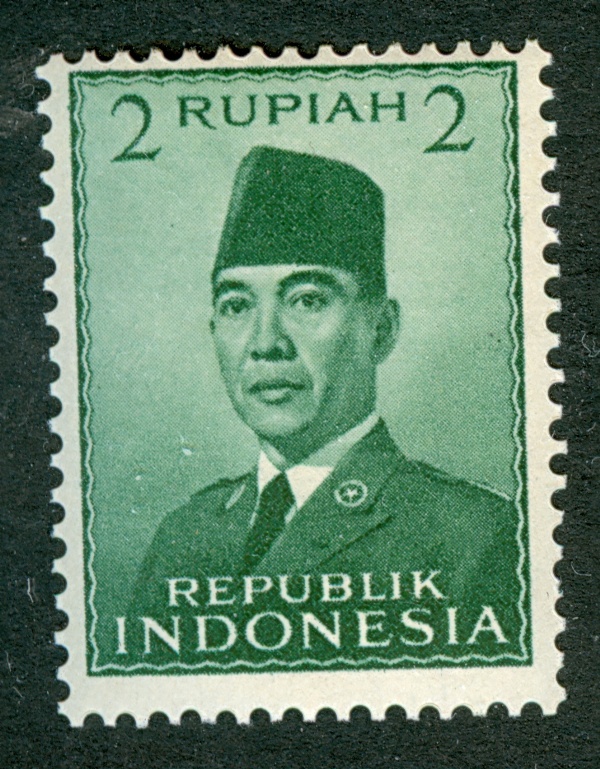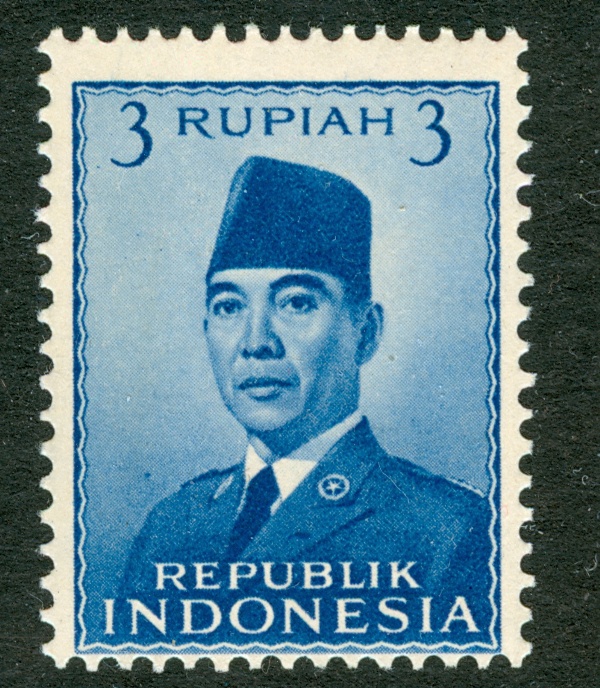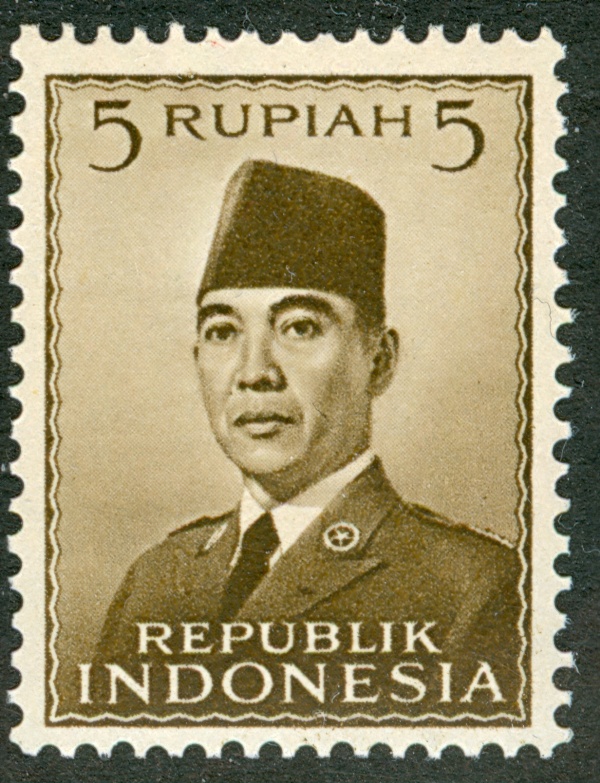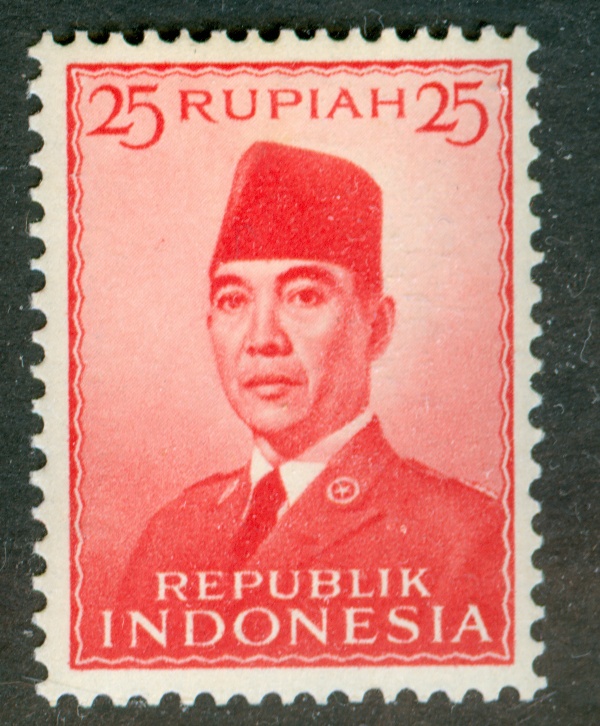Overzichts-tabel / Survey - Pres. Soekarno
Zoals het ook het geval is met de vorige behandelde emissies is deze in een aantal min of meer chronologische groepen op te delen / Just as has been done before on the previous definitives we like to make a few chronological groups:
- A
- Joh. Ensched?, doorzicht / paper type IIIb ↕ [1951-52] en / and IIId ↕ [1953], R80, UV-reactie D(of) / UV-reaction D(ull)
- B
- Kebajoran, doorzicht / paper type I ↕ , R80, UV-reactie / UV-reaction D, 1958-60
- C
- Kebajoran, doorzicht / paper type IIIb en / and 'IIIb, ↕, R80, UV-reactie / UV-reaction D, 1957-60?
- D
- Kebajoran, doorzicht / paper type I ↕ , R100, UV-reactie / UV-reaction D, 1961-62?
- E
- Kebajoran, doorzicht / paper type IIId ↕ , R100, UV-reactie / UV-reaction D, 1960-62
- F
- Kebajoran, doorzicht / paper type IIId en / and IIIb ↕, R100, UV-reactie / UV-reaction W, 1962-63
In de tabel zijn de bekende drukrichtingen aangegeven / In the table the known directions of printing have been mentioned.
| nummer / number | waarde / value | kleur / colour | afbeelding / illustration | A | B | C | D | E | F | |
| 1 | 1.- | paars / purple |  |
L | ||||||
| 2 | 1.25 | oranje / orange |  |
L | ||||||
| 3 | 1.50 | lichtbruin / light brown |  |
L | ||||||
| 4 | 2.- | groen / green |  |
L | ||||||
| 5 | 2.50 | lilabruin / ilaic-brown |  |
L | ||||||
| 6 | 3.- | blauw / blue |  |
L | ||||||
| 7 | 4.- | olijfgroen / olive-green |  |
L | ||||||
| 8 | 5.- | bruin / brown |  |
L | ||||||
| 9 | 6.- | roodviolet / red-violet |  |
L | ||||||
| 10 | 10.- | blauwgrijs / blue-grey |  |
L | ||||||
| 11 | 15.- | geel / yellow |  |
L | ||||||
| 12 | 20.- | donkersepia dark sepia |  |
L | ||||||
| 13 | 25.- | rood / red |  |
L | ||||||
| 14 | 40.- | groen / green |  |
L | ||||||
| 15 | 50.- | paars / purple |  |
L | ||||||
| Alle waarden behalve de 1.25 en de 1.50 hebben een iets andere plaats van het woord "Indonesia" ten opzichte van de golfvormige kaderrand. / All values - with rhe exception of the 1.25 and the 1.50 - have a slightly different position of the word "Indonesia" in realtion to the wavy frame: | ||||||||||
| Haarlem: | ||||||||||
 |
||||||||||
| Kebajoran: | ||||||||||
 |
||||||||||
| 16 | 1.- | paars / purple |  |
B,O | ||||||
| 17 | 1.25 | oranje / orange |  |
B,O | ||||||
| 18 | 1.50 | lichtbruin / light brown |  |
,O | B | B | ,O | |||
| 19 | 2.- | groen / green |  |
B | B,O | ,O | ||||
| 20 | 2.50 | lilabruin / lialac-brown |  |
B | B | B | ||||
| 21 | 3.- | blauw / blue |  |
B | B | B | ||||
| 22 | 4.- | olijfgroen / olive-green |  |
,O | B | B | ||||
| 23 | 5.- | bruin / brown |  |
B,O | ,O | B,O | ||||
| 24 | 6.- | roodviolet / red-violet |  |
B | B,O | |||||
| De waarden vanaf 15.- hebben verschillende tekeningen voor de Joh. Ensched? en Kebajoran drukken. Met name in de waardecijfers zitten verschillen in dikte, stijl en positie t.ov. kaderrand, Kebajoran heeft dikkere cijfers, grover uitgevoerd en soms net even iets anders gepositioneerd.. / The 15 rupiah and higher values were know to have a slightly dififerent design. Especially the ciphers have a variation of thickness, style, and relative position to the frame. The ciphers of Kebajoran are somewhat thicker, cruder and sometimes in a somewhat different position. | ||||||||||
| 25 | 10.- | blauwgrijs / blue-grey |  |
,O | B | B | ||||
| 26 | 15.- | geel / yellow |  |
B,O | ||||||
| 27 | 20.- | donkersepia / dark sepiaa |  |
B,O | ||||||
| 28 | 25.- | rood / red |  |
,O | ||||||
| 29 | 40.- | groen / green |  |
,O | ||||||
| 30 | 50.- | paars / purple |  |
B,O | ||||||
| RIAU [21 mei 1960] | ||||||||||
| 31 | 1.25 | oranje / orange |  |
B | ||||||
| 32 | 1.50 | lichtbruin / light brown |  |
B | ||||||
| 33 | 2.50 | lilabruin / lilac-brown |  |
B | ||||||
| 34 | 4.- | olijfgroen / olive-green |  |
B | ||||||
| 35 | 6.- | roodviolet / red-violet |  |
,O | ||||||
| 36 | 15.- | geel / yellow |  |
B | ||||||
| 37 | 20.- | donkersepia / dark sepia |  |
B | ||||||
| 38 | 40.- | groen / green |  |
B | ||||||
| 39 | 50.- | paars / purple |  |
B | ||||||
| Irian Barat [1 mei 1963] | ||||||||||
| 41 | 1.- | paars / purple |  |
B, | ||||||
| 42 | 2.- | groen / green |  |
B, | ||||||
| 43 | 3 .- | blauw / blue |  |
B, | ||||||
| 44 | 5.- | bruin / brown |  |
B, | ||||||
Proeven / Trials [?]:
kam / comb 12 1/2:12 15/19, dof papier / dull paper
1.25 geel / yellow
1.50 grijs / grey
2.- lichtblauw / light blue